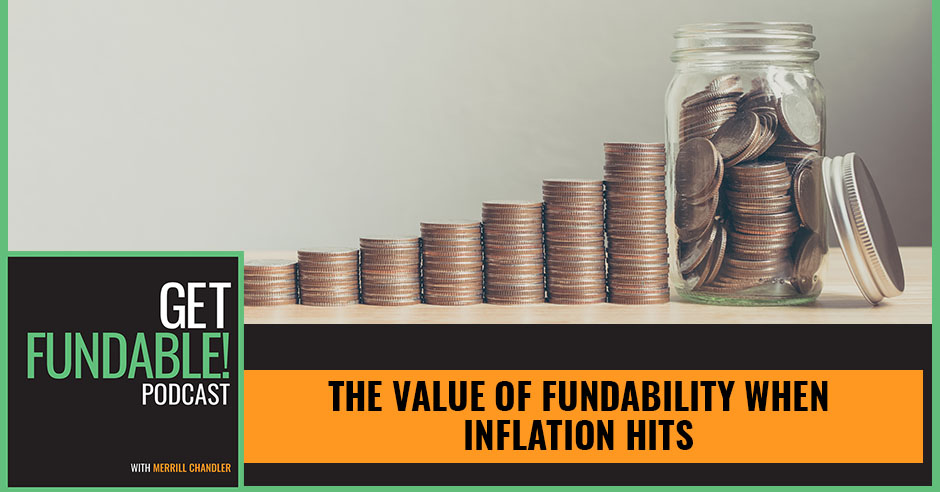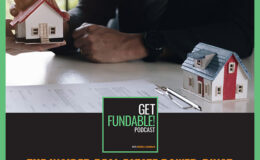
The aftereffects of COVID on the economy are still lingering and will stay for who knows how long. What is the value of fundability™ at a time like this? Merrill Chandler is here to break down what’s really going in the economy. Is it inflation? Or is it just a scarcity of resources that result to higher prices? He also discusses how you can take advantage and why now is the best time to get fundable. Stay tuned!
—
Watch the episode here:
Listen to the podcast here:
The Value Of Fundability™ When Inflation Hits
In this episode, we’re going to be talking about the idea of inflation and fundability™. We’re going to talk about what’s going on out there? Does it or does it not impact your credit approvals?
—
We’re going to talk about fundability™ in times of inflation. What does it mean? How does fundability™ work? How do the bank works? How does the fed work? How do we make our fundability™ apply when either money is flooding the economy or there’s a huge supply chain issue and prices are going up? Let’s get to it.
First of all, let’s define our terms. I do it every single time. Think of inflation as in relation to a balloon. You inflate a balloon. In the case of a balloon, there’s more air in the balloon than is naturally supposed to be there. The more air, the more pressure, those are the keywords, you put on the economy, the greater the inflation and the balloon continues to inflate.
Post-COVID, mid-COVID, whatever the life term of COVID is, prices are going up. To a significant degree, prices are going up because we had a near-complete halt in our economy for almost a year. Some experts say that it’s even over a year where manufacturing stopped significantly. The hospitality industry stopped completely. We weren’t even able to go and had to shelter in place.
The supply chain doesn’t just include the manufacturers here in the United States but from across the world. One of the biggest indicators of problems in the supply chain is that there are tankers in the China Sea, Sea of Japan, outside of India and massive amounts of backups. Sometimes, it’s 3 to 4 weeks before a container could either get in to drop off raw materials for manufacturing or pick up finished goods. Those 3 to 4 weeks behind also end up taking longer to get to the United States, at least in this particular case, and some things are not even available.
There are different types of supply chain issues, many of them occurring in our grocery stores. My roommate told me that they were limiting bottled distilled water to two per customer as they were going in. Years after COVID started and the big run on the grocery stores, distilled water is unavailable? This is why I wanted to define our terms. Technically, inflation is a superheated economy. We are not a superheated economy.

Value Of Fundability™: There is demand on the current supply which is increasing cost of labor. Increasing cost of labor is not a result of inflation but cost of scarcity.
We’re a car on square wheels. The square wheels aren’t even in sync. They’re all over the place. What we’re missing in the supply chain is affecting all the other places. To add to the supply chain, one of the greatest supply chain problems that we have is that somewhere, somehow, I was joking that the rapture occurred and took millions of workers out of the marketplace. They left. I don’t know why and where.
We have ideas why. Some are going into entrepreneurial pursuits because it’s time to pivot and they want to do something for themselves. The bottom line is that’s the greatest supply chain problem that we have. There is more demand on the supply, which is increasing the cost of labor. Increasing the cost of labor is not a result of inflation. It’s a cost of scarcity. It doesn’t hyperinflate or super-inflate the bubble or balloon of our economy.
The problem is that we have scarcity in a whole bunch of places, which is driving costs up. In turn, it gives the impression of inflation. Everybody from the Fed, pundits, everybody out there are talking. I don’t know if they’re panic mongers but everybody’s talking about, “Inflation is going up.” No, there is not an overheating of this economy. I’ll stand by that to my dying day. We’re just missing a lot of things.
The supply chain of fuel into the United States has caused a high demand. That is not inflation. That is a scarcity of a commodity that we have to pay more for. The result is turning into higher prices. Inflation and scarcity of products look the same but that’s the condition we’re in. In the ’70s, when people were lining up at the gas stations because of the oil crisis, there were blocks and blocks of people waiting to go fill up gas. There was rationing there.
The energy costs were through the roof because of scarcity. In the ’80s, there has been huge inflation. I was there when the economy was overheated. As a result, we had interest rates go through the roof. Do you remember the time where home mortgages were 10% and 12% plus? That’s the cheapest money in town.
Only through fundability™ are we ever going to have the lowest possible cost on our money. Click To TweetRegardless of the reason why we have high prices, some are calling it inflation. I’m calling it a supply chain mess. Including human beings are in short supply to staff the different positions that are available to keep our economy running smoothly. Regardless of that, how do we fare in the world of fundability™? Here’s the good news. One of the things that I love about this subject is that every one of us wants the lowest cost for our money.
Business loans from Tier 1 and 2 banks and business lines of credit are the least expensive money on the planet at any time regardless of low or high costs. Part of the reason why I felt that there’s a disconnect about inflation is I saw two banking reports where they went out on a limb saying that it’s likely they’re not going to raise interest rates through all of 2022. That’s perfect evidence that it’s not inflation. It’s supply chain problems.
Having set the stage, what do we do? How do we do it? What’s important if interest rates were to go up? First of all, every bank, every lender makes money when they lend. Even though there are fees and products that they sell, the number one source is interest income. One of the things that we want to address or need to be aware of is that you and I are not going to stop the process of prices or the cost of money going up.
If you think of the cheapest money available, let’s call it 5%, credit lines, loans from Tier 1 and 2 banks and credit unions. The next step up is private money. They’re usually 3 to 4 percentage points, so 8%, 9%, 10% for private money. Hard money is 3% to 4% more above that. You have your points, but then you’re going to be at 10%, 11%, 12% or higher for hard money. Those are the three big categories of money for real estate investors and entrepreneurs.
What we need to realize is that only through fundability™ are we ever going to have the lowest possible cost on our money. If hard money goes to 18% like it was in the ’80s, then it’s very expensive money. If prime goes to 8%, even private money is going to be 13%, 14%, 15% plus. The cheapest money on the planet is always going to be bank money and the money that you and I are seeking. Funding, God’s forbid, even if it costs us 10%, it’s going to be the lowest, cheapest and most inexpensive money available.

Value Of Fundability™: You have to be the bulls-eye borrower. You have to create the perfect relationship with your lenders and the perfect financial reputation so you can broadcast to future lenders.
The reason why I wanted to address this is that sometimes you’d be like, “What happens if it goes to 10% or 7%?” The most important point of fundability™ is that when we are the bullseye borrowers, the perfect lender-customer, we have optimized our 40 borrower behaviors to meet automatic and even manual underwriting guidelines, if we are spot on, then we will qualify for the lowest cost money available.
In fact, my mission statement says, “We help our borrowers, clients and students qualify for the lowest money available.” That cost could be 10%. It’s 4.5% to 5.5%. Fundability™ is not affected by inflation. Lenders are still going to want to lend. They’re going to lend at higher rates. If you want the lowest cost money, you’ve got to be fundable and that bullseye borrower. You have got to create the perfect relationship with your lenders and financial reputation so that you can broadcast that amazing financial reputation to future lenders.
That’s the magic. Hopefully, you weren’t expecting some crazy revelation, except for the fact that nothing changes. The banks are going to be the lowest cost money available. The only way to qualify over that is to be spot on in your fundability™. I hope things calm down quickly. Some people say that this is a spike in inflation and long-term will return. I don’t know how long it’s going to take for the supply chain to pull itself together and get more harmonious and synchronized.
The bottom line is that lenders are lending at the lowest prices in decades. If we are a bullseye borrower, hitting the funding bullseye of these lenders, we’re going to get the cheapest money available. This is a random and weird situation that we’re in. The cost of money is not going up but the cost of all goods, services, and employees is going up. We’ve got inexpensive money to solve these problems, which is awesome.
If you got credit lines, need to hire people to expand your business and raise those wages, the cost of your team members, the cheapest money available is still the going rate. It is awesome the cost of money. It’s funny how different presidents of different Fed branches say different things. The consensus is that while it’s spiking, we may return to something a little gentler based on the pre-COVID rate of inflation, which was very low at the time.
The cheapest money on the planet is always going to be bank money. Click To TweetWe’ve had a massive influx of money that is super liquid. Banks have made more money in 2021 per quarter than they were ever possible. They were five times more. It was $4 billion of profits in Q2 of 2021. It’s $20 billion-plus between the four top banks, Chase, Wells and Citi. What do we do? Get fundable and dial in your borrower behaviors.
If you haven’t been to the Bootcamp, go to GetFundableBootcamp.com. If you’re not reading all the episodes, binge the show. Whatever you’re doing, you’ve got to implement the strategies that are going to make you fundable. If rates are 5% for a credit line and massively fundable person, if prime goes up, do you want to be paying a premium of 2%, 3%, 4% because you’re not fundable? You don’t and we don’t want that for you either.
Get Fundable Bootcamp. If you have attended and are a gold level member, watched the bootcamps again. Join us for the Funding Hackers. In our Funding Hackers Group, we have points of accountability where we’re saying, “Are we on track or off track for our goals?” We’re holding you accountable. Come and join us. Let’s become as fundable as possible like what my mission statement says, so we always have access to the least expensive money available. I’ll see you on the inside.
Important Links:
- GetFundableBootcamp.com
- Funding Hackers – Facebook




